Missing Running Events but Still Grateful to Run
“Gratitude turns what we have into enough.”
This week’s blog comes on the heels of a good week – and one that could have been a rough one.
Saturday was supposed to be the Fargo Marathon. I trained for the marathon through most of the early part of this year and, before I heard of its postponement to August, had every intention of being at the start line alongside my fellow pacers and runners. I was especially looking forward to running my second marathon while pregnant (I ran Chicago Marathon back in 2018 while 15 weeks along with my son).
Everything I Love About Running Marathons
I spent all last week slightly on edge. Normally, I’d be fully on edge, obsessively checking the weather, closely monitoring my food and water intake, and carefully scheduling those last few taper runs and recovery efforts.
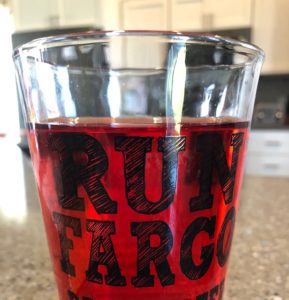
Normally one of my favorite weeks every year – Fargo Marathon week
So why still slightly on edge? I think I was greatly missing that fully on edge time.
See, I love everything about marathon training. I love the euphoria after a successful long run and also the angst of gutting out the tough ones. I love the feeling of my body being strong and fit and also the slight aches and pains that come with working hard. I especially have no problem fully embracing an exceptionally large appetite. Sure, I have tough days where I don’t feel like running and days I’m tired and would rather sleep in than stick to my schedule. But I even still love that.
I also really love the week before the marathon. I’ve learned to love the taper. I love the relaxed, shorter runs, the planning and organizing for race day, seeing the Fargo Marathon signage and road markings make their appearance, and especially going to the expo. Add the icing on the cake, the actual run itself, and it’s become one of my favorite weeks every year.
I really missed all that.
Grieving then Moving On
While I have no shame admitting I spent a little time feeling bummed and sad (okay, most of Saturday and even part of Sunday) I tried to spend more time reflecting on all the good things that came from not running the marathon.
Instead of spending my Saturday mornings prepping, running, and stretching, I slept in and enjoyed pancakes in pjs with my son.
I embraced the opportunity to be flexible with my running schedule to skip days when the weather was less than favorable.
Rather than tough it out and visit my physical therapist every week, I chose to scale back and rest when I started to feel the really tough aches and pains come on (it’s true what everyone says – the second pregnancy really is harder than the first).

This old man can’t run very far anymore so enjoying shorter runs with him.
But most of all, I still enjoy daily and weekend runs, with less pressure on myself to hit strict pace or mileage goals. Because, while not running Fargo Marathon for the first time in more than a dozen years definitely was tough, not getting to run the marathon doesn’t mean I don’t get to run.
We Still Get to Run
I think that’s the most important piece of this experience – being okay to be sad about what I missed out on but also being grateful for what I have, that I’m still able to run and that I’m still enjoying the miles. For some, this means continuing what we’ve always done, for others, this has been a great time to start running.
True, our races might be canceled (for how long, no one knows). But I’m here to remind you what’s important: running is not canceled. We still get to run. Grieve the loss of your race, that’s totally okay. Then, keep running.
And who knows, maybe my body wouldn’t have help us as strong through all those miles had I not taken it easier. All I know for sure, right now, is I feel good and healthy, right now, another positive.
While Saturday was tough, the rest of the weekend was full of positivity, bookended with a birthday on Friday and Mother’s Day on Sunday which, for me, pretty much just means more reason to eat good food and extra sunshine that comes from all the text, Facebook, and in-person messages from friends and family.
Not a marathon but still pretty great.
Have you found yourself in a similar situation, bummed about missing out on something that was canceled due to COVID-19? After allowing yourself the okay to be bummed, did you try to focus on the positive side of it?
The comments are your space to share thoughts so please do so. Or, connect with me @lindsayinreallife on Instagram or @LindsayIRL on Twitter. Subscribe to Wellness in Real Life so you get every new blog post straight to your inbox.
Easy Berry Muffin Recipe and Making the Best of What You Have
“Life is what you bake of it.”
Lately I’ve been doing more cooking and baking – and by ‘more’ I mean I’ve baked muffins twice in the past two weekends and have made actual meals with leftovers a couple times too.
I typically don’t do much of either; I strive for quick and easy when it comes to food and have found there are plenty of meals that fall into that category that are also delish, healthy, and satisfying. But on occasion, I get the urge to make something.
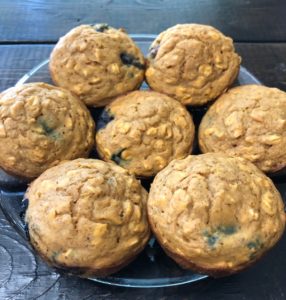
A variation of my Very Good muffins with pumpkin and blueberries.
One of the (if not THE) only things I’ve figured out how to bake well is my Very Berry Banana Oat Muffins, a recipe I tinkered with for awhile before I got it right – and, honestly, it still sometimes doesn’t turn out perfectly but that’s baking.
Anyway, I was revisiting the recipe and, both due to the spice of life we call variety and the lack of certain ingredients in my home, I’ve made a few twists on it each time I’ve made them lately. My latest: a pumpkin muffin twist. They turned out pretty well so I updated the recipe and it’s under the Breakfast tab of my Yum, Food section.
I know, I know – there’s not much in there. What can I say, I don’t have many fantastic recipes worth writing down. I’m more of a “sloppy eggs on avocado and hummus toast with cucumber and tomato slices” or “zucchini noodles with whatever veggies you have in the fridge thrown in” kind of gal. The recipe is pretty much in the name.
Anyway, a final thought. The experience was one of those tales of adaptation and positivity – don’t focus on what’s missing or what you don’t have, do what you can with what you have. And, best of all, you come out of it with a bunch of tasty muffins to eat. So, pretty much a win win.
Have you been baking or cooking more during this COVID-19 quarantine life? What are some new twists on recipes or new creations you’re coming up with?
The comments are your space to share thoughts so please do so. Or, connect with me @lindsayinreallife on Instagram or @LindsayIRL on Twitter. Subscribe to Wellness in Real Life so you get every new blog post straight to your inbox.
How to Get Started Running – 7 Tips for New Runners
“Start where you are.”
There are many reasons to run. Even with all the positives, some people want no part of it. They hate it. They think it sucks.
I get it. I used to be one of these people. One of my first blogs ever was about how I went from hating running to becoming a runner – and loving it.
Right now though, there have never been more reasons to run. It’s a chance to get outside. It’s a chance to escape for a few minutes to yourself. It’s a chance to set aside fear and do something powerful. And, for some, it’s quite literally the only exercise option, with gyms closed and at-home workouts not everyone’s cup of tea. It’s the perfect opportunity to build a healthy habit of running.
More Reasons to Run – And One Reason Not To
Although gyms may be opening soon, adding the simple environmental facts that weather is getting nicer and days longer presents an even greater opportunity to start running.

Abel recently decided he wanted to get out of the stroller & start running. We have such fun.
If you’re thinking about giving it a go, here are a few tips from me, a former anti-runner, on how to get started running.
But first, I have one pre-list tip: If you’re really not interested in running, if you’re only thinking about it because you feel like you should, don’t do it. That’s all.
1. The Right Gear
Although it might seem premature to go out and buy running stuff before you really even get started, it’s an important first step. Why? Running will be miserable if you don’t have the right gear. Think of chafing and other forms of general discomfort, all the way up to pain in your feet or other potential injuries.
On this same note, don’t feel like you have to go out and buy all the things. You probably don’t need a fancy watch, compression socks, the most expensive shoes, or a variety of belts, bottles, and night gear.
All you really need to start is a good pair of shoes, proper-fitting shorts or pants, a moisture-wicking tee, and quality athletic socks – some of which you might already have. Ladies, one additional thing you’ll want is a good sports bra that holds your boobs in place.
For all the parents out there, a good running stroller may be another piece of gear worth the investment. No excuses of not being able to go when you can bring the kiddo with you – bonus, if they’re like my son, they’ll enjoy the time…and it’ll be some of the few moments of peace from them you get all day.
2. Start Slow
Maybe you ran an 8-minute mile in high school. Perhaps you saw your friend post their 5k time on Facebook. Whatever the reason behind having a pace you think you should run, avoid going into the first few runs with any sort of pace-per-mile goal.
When starting out, run at a pace that’s comfortable. This will help avoid burning out too fast and potential injury. You’ll have plenty of time to build from there.
3. Minimal Mileage
Similar to pace, don’t try to run too far too soon. Again, it might seem like a total breeze to head out and do a 5k but, even if your head tells you to keep going and you’re in fairly good cardio shape, your body might not be up for it.
One option is to try running for a minute or a few, then walk for a few minutes. Gradually work on extending the running minutes and eventually you’ll reach a point where a full mile or more is more than doable, it’s comfortable.
4. Find a Buddy
One of the reasons I started running and stuck with it early on is because I had a friend, Jen, who was also getting into it. We often ran together and, even when we didn’t, we’d keep in touch about our runs and keep each other on track.

One of my virtual running buddies, Lee – I convinced him to run a race with me & he instead smoked me by a solid 10 mins 🙂
While I no longer have many people I run with, and especially not now, I have virtual running buddies, both those I regularly text and those in online groups that keep up that runner connection and inspo.
And a buddy doesn’t have to be an actual human. For many years, my dog, Burton was my go-to running buddy. Especially on days I wasn’t really feeling it, his energy and annoying-ness forced me to get up and get out the door – and, almost always, I was happy we went.
5. Recover
Starting a running routine is exciting and, while some find it’s hard to stick to it, others find it’s hard to lay off it. It’s important to be sure you’re not overdoing it and only running. It’s equally important to focus on strengthening your runner muscles, for some that may be your hamstrings, for others, especially mamas, that’s your pelvic floor. Switching up your running with other forms of exercise is also a good idea.
On that same note, healthy running isn’t just about the run itself. An easy, light warm-up and a quality cool-down stretch or yoga sesh are good injury-prevention, as is taking a rest day when you need one and giving your body a break.
6. Set a Goal – and Have a Plan for How to Get There
As with anything fitness related, having a goal is key to sticking with it. If you’re just looking to run now until your gym opens up, this step isn’t as crucial – though that right there is your goal. If you’re looking to build a running habit and stick with it, a goal is a must.
And a goal doesn’t have to be a 5k race or anything along those lines. A goal can simply be to run twice a week – that’s it. Just getting yourself up and out the door (or on the ‘mill) to get in the run is a quality goal. Figure out what you need to do to achieve that, maybe it’s going early in the morning before your kids get up, maybe it means going in the evening when your energy is highest.
Another goal-setting must is choose something realistic and measurable, that way you can reflect on what happened if you miss it one week (which is totally normal and okay – don’t give up!) or, if you’re consistently crushing it, maybe it’s the right time to push yourself and up it for the next week.
7. Stick With It
Some days, running is great. Some days, running sucks. I’ve been running almost 15 years and I still have days I don’t want to do it. Some of those days, I don’t. Others, I need a little more internal coaching to psych myself up. Don’t give up and let those bad days prevent you from having the good ones.
I think when people give up on running it’s because they think they just don’t love it, it doesn’t come easy to them, or they’re just not like those runners who have it figured out. I can’t speak for all runners but I can tell you one thing: I don’t have it all figured out. What I know is how good running makes me feel and that keeps me happy to stick with it, even with tough days.
Most days, I genuinely love it but I’m certainly not immune to the ‘running sucks’ feelings every now and then. It doesn’t mean you’re missing some magic running gene, it means you’re human.
The point: Don’t quit running. That doesn’t mean don’t take a week off. That doesn’t mean you must run every day of the week. As much as you can, try to stick with it at some level of consistency. Because, as you may be experiencing right now, starting up or starting over is tough.
Side note, if you’re interested in more healthy habit building, check out my tips from last month’s edition, how to start being mindful or meditating.
Fellow runners, what other tips do you have for getting started running? Those of you who aren’t regular runners, have you found yourself wanting to hit the pavement during COVID-19 quarantine or because the weather is becoming more favorable to encourage it?
The comments are all yours so please share your thoughts.
Connect with me @lindsayinreallife on Instagram or @LindsayIRL on Twitter. Subscribe to Wellness in Real Life so you get every new blog post straight to your inbox.
Ideas for What To Do With Race Medals, Bibs, and Other Goods
“Creativity is contagious. Let’s pass it on.”
If you’re like me, and most runners, you save your race medals, bibs, and other various race day goods.
If you’re like me, and most runners, you probably have intentions of doing something creative to display or save this memorabilia.
If you’re like me, all this stuff gets tossed in boxes and put in piles, never to actually be displayed or housed creatively.
It’s okay. Pretty sure that last one applies to most runners but I don’t want to assume everyone’s as lazy…er, lacking creativity…as I am.
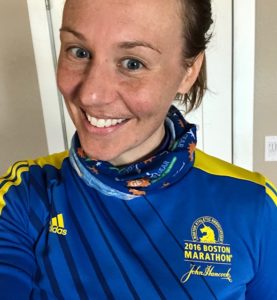
We can still run for Boston this year.
Maybe it’s because of this coronavirus quarantine life we’re all still living, maybe because I’m sad about my May marathon being canceled, or maybe because it’s Boston Marathon time – whatever the reason, I’m proud to say I finally did a project with, not one, but THREE sets of goodies from races.
A Trifecta Approach
Some races, usually full marathons, offer runners a foil wrap at the finish to help keep your temperature from dropping too quickly. I always keep these, again, with the intention of doing something with them…just never actually doing anything with them.
The race medal and bib are pretty obvious keepsakes, but I wanted a way to incorporate all three items into a cool display. After thinking about it and doing some searching for the right frames, I decided I’d create a frame display, with the blanket as the backdrop for the bib and medal.
Because Fargo Marathon finishes indoors (which is pretty rad), Fargo finishers don’t receive the foil blankets. But I did have three from Boston, Chicago, and Duluth, so I decided that would be a perfect lineup to frame. A nice little non-Fargo trifecta and three of my most memorable races.
I ran Chicago when I was pregnant with my son, Duluth was my first marathon after he was born, plus I ran it alongside my longest best friend for her first full marathon. And Boston was, well, running Boston. The ultimate dream.
I simply cut the blankets to fill up the frame, minus the matt, then arranged the bib and medal as I thought would look best, with some wiggle room as I realized they’d shift a bit as I flipped it over to properly display in the frame.
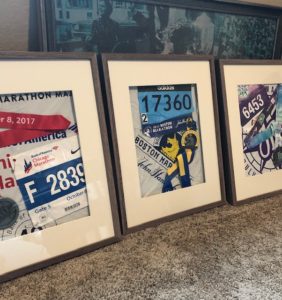
Tah dah!
It was fairly easy and didn’t take a ton of time. I’m so excited about how they turned out and they’ll be the perfect décor for the new gym nook we’ve created in our basement.
Now, I still have a pretty sizeable stack of medals, bibs, and other race stuff that remains in piles and boxes. So I’m still in need of more creative ways are there to display them.
What have you done with your race medals, bibs, and other goods? Or do you have a really good idea planned in your head? I’d love your ideas. After all, as the quote reads in this blog, creativity is contagious. In a time of COVID-19 and unpleasant contagions, let’s pass along some creativity germs to each other!
The comments are all yours and I’d love more ideas so please share.
Connect with me @lindsayinreallife on Instagram or @LindsayIRL on Twitter. Subscribe to Wellness in Real Life so you get every new blog post straight to your inbox.
Don’t Try Something New If You Think You Have To or Should
“Just put on pants.”
Acquire a new skill. Try a new workout. Start a podcast. Learn a new language. Write a book.
Wow, with all the pressure already on the world not to collapse, there’s suddenly a ton of pressure on all of us to improve ourselves or accomplish a whole fuckton of things beyond staying healthy, both physically and mentally.
If you’re like me, you might have seen a ton of articles, social posts, even TV spots about all the great things you can be doing while spending more time at home. If you’re also like me, you might feel like you’re not ‘taking advantage’ of this time by doing something extraordinary.
I’m not doing anything extraordinary. I’m not running a marathon in my backyard or writing a book. I’m not launching a YouTube series or taking up pottery. My days are actually fairly normal, in a sense, so I’m doing things I’d normally do. But even if your days aren’t so routine anymore, you might not be doing any of those things either. And that’s okay.
Having a Routine
What are you doing right now? Ideally you have a routine but I realize that’s not happening for some. Me, I get up around the same time each day, then eat breakfast and take some mindful time for the day. My son gets up so I help get him ready, then get myself ready and go to work – although now I go to work in my kitchen, not my office building.

How are you? Are you okay?
I start the day by watching and reading the news, as well as social media, then trying to separate the paralysis of negativity in what’s going on from my actual purpose of staying informed and up on what people are sharing (I work in the public relations field). Then I dive into the day’s tasks. I usually take a break to exercise at lunch because I love to exercise and the break is important, then back to it.
My husband and son come home, I unplug and hang with them. We do our usual family time, if it’s nice out I take Abel for a walk or run in the stroller or we play outside, then it’s dinner, bath, and bedtime for the little guy, followed by my dinner, catching up with my husband, and relaxing with one of our shows – and, some nights, plugging back in and taking care of work that needs to get done.
I’m super fortunate to still be working full-time. I’m super fortunate that my day-to-day is still filled with much of my normal, like being a good employee, mother, wife, and carer of myself. I’m super fortunate this is allowing me to keep a sense of routine in an otherwise chaotic time.
It’s Okay To Just Be Okay
Some people aren’t as fortunate. Their normals aren’t there. For some that means more time, without work or social activities, for others that means less time, with homeschooling, more cooking and cleaning, or possibly caring for a sick family member – or self, and dealing with all the news.
Even if you find yourself in any degree of the camp that equals more time or non-routine time, I’m here to support you in the reality that you may not accomplish anything great during this time. And that’s okay.
You don’t need to master a new skill, try the latest new workouts, start up a podcast, learn a new language, or write a book. I feel like there’s so much social pressure right now to be using all of this “extra” time to make incredible life changes or accomplishments.
It’s also by far one of the most batshit crazy times I think many of us have lived through. It’s scary for so many reasons. The mental and physical capacity fear, worry, and anxiety take up is real. If you need to escape with a Netflix binge of Parks & Recreation or watch Tommy Boy three times back-to-back to feel a sliver of calm and happy, that my friend is worthwhile, productive time well spent.
I think back to my maternity leave. I started out feeling bad if I didn’t do the dishes, keep the house clean, get all the laundry done, read a book, do yoga when the baby napped (he didn’t, for the record) and, the big one, get outside – because being a new mother and taking baby out is terrifying but everyone harps on you if you don’t “get out of the house” because you need to, so then you feel bad if you don’t, but you’re so full of anxiety when you do…yikes, okay I had a point, sorry back to it.
My point is, I quickly learned that some days, I would survive, not thrive. And that was okay. I was keeping a tiny human alive, one who relied on me for absolutely everything, and that was enough. I tell every new mom this, when they feel like they’re not doing enough or the only thing they did all day was breastfeed and get the baby down for naps. High-fives, new moms, that is a day where you did your best and you did what you needed to do. I think every parent, mother or father, can relate to this.
Folks, we’re in a similar situation right now. Every day is not going to be a day that you thrive, some days, it might just be the one where you survive. And THAT’S OKAY.
What To Do During Quarantine
Here’s a list of things you do need to do right now. You DO need to take care of your physical and mental health. You need to be honest with yourself about how you’re dealing, and do what’s needed to get through the day, ideally with smiles, laughs, and bursts of positivity. That’s it. This is a time of unprecedented chaos and confusion, rules and new normals. Dealing with that is enough, some days more than others.

Getting outside is huge for me – for a run, a walk, or to work!
Now, that’s not to say you shouldn’t try to do something. If you like to read, get into a book. If you like to write, keep on with journaling. If you like (or tolerate) exercise, absolutely do it six days a week. If you like to clean and organize, do it often. Being totally unoccupied is just opening up your brain to more worry, what-if scenarios, and anxiety.
The point is, do what makes you feel good and do not feel bad if you’re not doing “enough” these days. I don’t ever advocate for doing absolutely nothing, but I do advocate for doing things you want to do, not those you feel you have to or should do.
In addition to doing what you normally would and maybe something new you want to do, I would encourage you to try a couple of things that might be new or irregular. Rest. Relax. Re-prioritize what’s important in your day to day. Take time to be mindful or meditate, to acknowledge gratitude every day, and keep thinking in short and long-term perspective.
Just Put On Pants
I’m not sure if you’ve read or watched any “experts” share advice on working from home, but the #1 thing many of them share: put on pants. Real pants. Seriously, that’s it. That’s the benchmark of productivity and having it together during this pandemic. Putting.on.pants.
Let’s all calm down and not feel guilty if we don’t run a marathon on our balcony or learn to sew or write this generation’s version of We Didn’t Start the Fire (though that would be really rad, someone should do that…Mr. Joel?) and keep things in perspective.
I guess, one skill I can say I’m working on is decision-making, as I decide which local restaurant I’m going to order food from that day. I wish I could say it was going well but I’m as horrible as ever at choosing food with so many wonderful options.
For some people, now absolutely be the time to try something new. If you’re one of those people, ensure it’s coming from a place of truly wanting, not feeling like you have to or should.
What’s your gauge of productivity during the COVID-19 chaos? Are you proud of or simply happy with anything you’ve done? Bigger question: Do you feel okay or are you struggling? The comments are your space to share thoughts or ask questions so please do so, and let’s help each other out with positivity and taking off the pressure.
Connect with me @lindsayinreallife on Instagram or @LindsayIRL on Twitter. Subscribe to Wellness in Real Life so you get every new blog post straight to your inbox.
30 Minutes or Less – Fast Weight Workouts to do at Home or the Gym
“Feel the burn.”
What’s the #1 reason for skipping workouts or not prioritizing them altogether? I mean, aside from when gyms are closed and we’re all trying to do our part and stay home.
Time is the main reason workouts get skipped, right? It happens to everyone, even those who love exercise and are good at making time for it. Between work and activities and charitable causes and kids and housework and friends – and, of course, sleep – some days, there’s just not enough time to do it all, a workout isn’t high enough on the priority list.
And that’s okay. Not every day has to include a workout as priority time. Even though we all get 24 hours every day, those 24 hours get eaten up fast.
Another offshoot of the ‘not enough time’ reasoning, it’s easy to fall into the trap of, “There’s not enough time…for a good workout…so I may as well just not do one.”

No matter the workout, a good stretch should be included
Oh, but on the contrary. Any and all exercise matters.
Given what we’re all going through right now with most people practicing physical distancing, some full-on quarantining in their homes, and hopefully all of us limiting exposure to the outside world, exercise becomes more important than ever. The mood-boost, stress-relief, and simple normalcy it provides shouldn’t end because we’re limited in other regular activities.
A Quick, Effective Workout
Going back to the scapegoat of ‘not enough time’ preventing us from working out, there are plenty of strategies to get in a quick and efficient workout.
There are about a million people and companies offering at-home workouts right now so I’m certainly not here to add to that. Rather, I have a perspective, a plan most people can take now or apply to future life when, dare I say it, things go back to normal.
While most immediately ‘cardio’ and working up a sweat come to mind when thinking workout, resistance training shouldn’t be overlooked. And there are plenty of ways to get a great lift in a short amount of time.
Now, I know people who regularly spend 45 minutes or even more with each lifting workout. Me, I’ve learned I can get in a solid lift in much shorter time – easily 30 minutes or less. One of the last times I was able to go to the gym, I really raised the bar – or lowered it, I guess? – by cutting that down to 19 minutes. A good, heart-pumping, muscle-fatiguing lift sesh in less than 20 minutes.
Here’s my formula for fast, efficient lifts. Hopefully this helps with those ‘time’ excuses or can be used as you’re doing workouts from trusted companies or trainers.
I should note, this is meant for the average exerciser; someone who’s accustomed to lifting for at least an hour, super heavy and intense might not find this valuable. But, for most, this is more than adequate for feeling a burn and those days when time is crunched.
Resistance Workout Method
First: choose two muscle groups to target, such as back and shoulders or chest and triceps.
Quick note: there are workouts being shared out there that have you working all the muscle groups in one session, similar to the philosophy of a BodyPump class. Those aren’t wrong but, for this quick and efficient method, let’s stick to two groups and really focus on fatiguing them.
Second: plan ahead so you know what you’re going to do and can move quickly between sets. I like to choose two different exercises to do back-to-back as a set, that way it’s easier to keep up the pace.
Example, today I worked back and shoulders. I decided I would do front and side lifts (set one), seated row and lat pulldowns (set two), overhead presses and bent-over single rows (set three) – all with resistance bands.
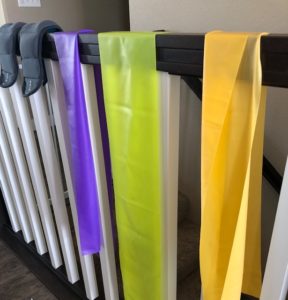
There’s a lot that can be done with a simple set of resistance bands
A lower-body option targeting glutes and hamstrings: Standard squats and stiff-leg deadlifts (set one), bridges and deadlifts (set two), donkey kicks and single-leg deadlifts (set three). For lower body, I use a mix of weights, ankle weights, resistance bands, and simple bodyweight.
Here are a couple of older blogs to give you additional ideas for lower body exercises. One is a bodyweight circuit – no equipment required; the other does have some gym-inspired moves but is just good ideas for lower body exercises.
To Sweat or Not to Sweat
This strategy should take around 20 minutes, depending on how fast you move between sets. It can be done on its own or, one thing I like to do, is break it up with cardio in between, creating almost a circuit.
I have an elliptical; often I’ll do five mins on that, break to do a set, then back and so on until I’m finished. The same could be done with a treadmill or bike, or non-equipment style with mixes of marching, skaters, jumping jacks, endless possibilities.
If you are indeed looking for an opportunity to really break a sweat and get your heart rate up, I suggest the circuit approach. However, if you’re rushed for time and don’t want to sweat (as in, don’t have time to shower), sticking to just the resistance work shouldn’t get you sweaty enough to require a shower.
And I should know, I have, shall we say, active sweat glands. You can call me an aggressive sweater. Bottom line, I sweat easily. No shame.
I hope this simple strategy I’ve adopted and love helps you in your quest to lift, whether you’re just getting started and need a basic formula to begin or you’re looking to make it more efficient or work from your house if you can’t get to the gym.
How are you handling at-home workouts? Is that a new concept or is it normal for you? What other tips do you have to share for working out at home or efficient, quick workouts that deliver? The comments are your space to share thoughts or ask questions so please do so.
Connect with me @lindsayinreallife on Instagram or @LindsayIRL on Twitter. Subscribe to Wellness in Real Life so you get every new blog post straight to your inbox.
Tips for Building Healthy Habits – Meditation and Mindfulness
“Wherever you are, be there totally.”
It’s an unbelievable time we’re living in, friends. If anyone would have foreshadowed the coronavirus situation we’re in, as a community, as a country, as a global population, I don’t think you’d find one person who’d have ever thought it was even remotely possible.
But here we are, with new COVID-19 changes happening by the day, sometimes by the hour, and life as we’ve known it is no longer the same. It will be again, someday, but not right now and certainly not any time soon.
How COVID-19 Is Affecting Us
My job is in communications so, naturally, I’ve been spending plenty of time watching the news, reading the news, and seeing how our new normal is unfolding on social media. All of this between eating second breakfast, lots of Teams meetings, and, obviously, enjoying the background noise of old episodes of The Office and Seinfeld in the background.
One of the stories that caught my eye last week is that downloads for meditation apps are up significantly within the past couple of weeks. It makes me think that it’s all really starting to catch up with us, take a toll on people – all the social distancing, working from home, and how this type of unprecedented situation has made trying to do our jobs pure madness, at best.
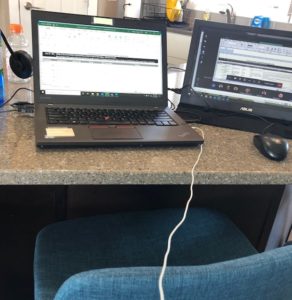
A new normal for many of us – working at home.
I decided this would be a great topic for this month’s opportunity focus: meditation and mindfulness.
Now more than ever, I think it’s in everyone’s best interest to practice some form of daily mindfulness or meditation to keep ourselves sane, focused, and perhaps most importantly, grateful, amidst all the chaos that can too easily bring us down and defeat even the most positive person.
Meditation and Mindfulness
What are we talking about with starting a mediation or mindfulness practice? Let’s begin with, what I believe is the simpler act of the two, mindfulness.
The practice of mindfulness is a bit easier to grasp than meditation, simply because I think the word and concept of meditation in itself freaks people out a bit and conjures up thoughts of long-haired people in white linen pants sitting cross-legged and humming “ohm” over and over.
Yet, to my knowledge, the concept of mindfulness is appealing to most people. The idea of slowing down to speed up, of taking a few pauses during the day to check in, and the discipline of being a bit more self-aware about everything, from positive word choices on your next conference call to whether or not you really want that second breakfast (and if the answer is yes, that’s 100% acceptable. Eat that second breakfast.).
Meditation, on the other hand, is a little more intimidating. However, the concepts really aren’t much different. Both concepts have essentially the same benefits, reducing stress and anxiety among them, are intentional acts, and are about achieving a position of being fully present.
The real difference, as I see it and putting it very simply, is that while mindfulness is meant to be practiced frequently throughout the day, in quick bursts, meditation is a much more focused practice. It really deserves more time and focus to truly clear the mind, get to a state of total awareness, and achieve a sense of calm.
How to Create A Healthy Habit
Before talking about creating either one as a habit, let’s go back to the foundation of this healthy habits series. Like any habit, the desire and a goal along with it are important. Please don’t go into this with anything less than both.
First ask yourself, why do I want to build this healthy habit? Do I really want to or do I feel like I should? Find that purpose, that desire.
If you really want to, the second step is to set your goal and be specific about it. A goal gives you something to measure, something to gauge success, and see where adjustments or improvements could be made.
In this case, you could set a goal to practice mindfulness before every meal. Another goal would be commit to a 15-minute yoga meditation three times a week. Any goal is acceptable and there’s really no “wrong” way to do mindfulness or meditation. Here are a few tips to get started.
First – Mindfulness Basics
Mindfulness is a great healthy habit to adopt. To get started, there are a couple places one can begin.
Figure out times during the day that you could work in mindfulness. One of the best ways to find times for mindfulness is repetitive actions – every time you sit down to eat, every time you get into the car, every time you sit down at your desk, those types of things.
One of the simplest mindful actions is to take a few deep breaths. Pause. Be aware for those moments. Take a moment to slow down, acknowledge, be aware, then act.
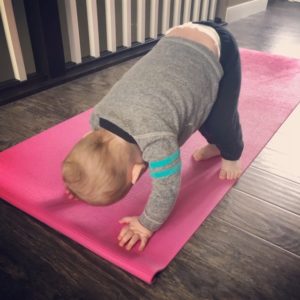
One of my favorite meditation practices – yoga.
First – Meditation Basics
Meditation and mindfulness are pretty similar. In fact, some of the same basic points of meditation apply to mindfulness. Simple acts of deep breathing and finding awareness of, everything from that breath to the feeling from your fingertips to your toes.
Meditation requires a bit more dedication, time, and focus, so, again, choose a time to do it regularly that coincides with a routine or perhaps a time of day that’s ultra-stressful and could benefit from calm and focus.
Next – How to Practice Mindfulness
To begin practicing mindfulness, choose that time of day or that regular, repetitive action that lends itself to a brief moment of pause and clarity.
One example is to start the day in a mindful place, beginning with breakfast or coffee. Don’t turn on the TV or look at your phone, instead, take a few deep breaths before taking a bite or sip. Eat and drink slowly, taking time to breath, enjoy the simple pleasure of the food or coffee, and think about how you want to show up today. Gain perspective on challenges you know are going to come your way and what really matters that day.
Another ideal time for mindfulness is when you sit down at your desk. This could be the start of the workday, after going to the bathroom, or returning from a meeting – all opportunities to take a few seconds of deep breaths and focus and get back to the right state of mind.
One of the great things about mindfulness, once the practice begins, it’s easier to incorporate into more activities. It can be done often and while doing other things – yet it’s not the same as multitasking because you’re not trying to do something, rather you’re giving deeper focus and attention to what you’re already doing.
People think I’m crazy, but I don’t use headphones when I run outside – even on three-hour long runs. I use that time for focused, mindful thinking. I gain perspective on challenges in my life. I give gratitude for the health and ability to run (that one comes in handy when I’m fatigued, hurting, or just not feeling it). And, admittedly, I think about food. There are a lot of food thoughts.
Next – How to Practice Meditation
Similar to mindfulness, choosing a consistent time of day is one idea to get started with a meditation practice. Eventually, you might find there are certain times in the day that work better or those where meditation is really needed.
A great way to practice meditation is through yoga. Start the process by just sitting and taking deep breaths, then noticing how you feel through the different poses.
If yoga’s not your thing, skip the poses and just sit quietly, taking deep breaths and getting that deeper sense of being in touch with yourself. That’s really what meditation is all about. The act of doing nothing yet some of the most productive ‘nothing’ there is. Being still, being aware, gaining so much.
Again, these are just basic ideas to get started with mindfulness or meditation. Remember, there’s really no wrong way to practice mindfulness and meditation, as long as it’s serving as a way to find more calm, clarity, focus, and positivity.
Those following along with the monthly wellness opportunities, please share feedback on this one. Additional tips? Opportunities that didn’t work so well? The comments are your space to share thoughts or ask questions so please do so.
In case you missed it, check out January’s healthy habit opportunity: tips to create a gratitude habit and February’s healthy habit opportunity: tips to eat more inclusively.
Connect with me @lindsayinreallife on Instagram or @LindsayIRL on Twitter. Subscribe to Wellness in Real Life so you get every new blog post straight to your inbox.
When Things Are Unknown and Out of Your Control, Find the Positive
“From chaos comes clarity.”
Recently, I was reminded about the importance to focus on the positive and not get caught up in the negativity of things I can’t control.
I imagine a lot of people are feeling this right now in some way, shape, or form.
For me, it all started with a little bug.
When Life Doesn’t Go According to Plan
I got hit with a terrible cold bug last Friday. I was hopeful that extra rest in the afternoon and a good night’s sleep would be all I needed to feel up to my Saturday long run. That was silly.
I spent most of Saturday, Sunday, and Monday in bed. The rest of the week was spent working from home in partial quarantine while I continued to have a sore throat, stuffy nose, and nasty cough that was not acceptable to bring into the workplace.

Looking forward to days like this.
That’s the thing about colds. They stick around. They linger. It’s not like the flu where it’s a day or two that you’re down for the count, full-on misery, but then things feel better pretty quickly.
Because of the longevity of this particular bug, not only did I miss my weekend long run, I missed the entire following week. And, naturally, it was some of the nicest, springy-est weather we’ve had yet.
The Stages of Running FOMO Grief
My first instinct was to be super bummed and feel sorry for myself, then move on to wonder if my entire training was down the tubes, if I’d have to miss my next marathon, probably never run one again. Whew, good thing I didn’t overreact.
It is a tough place to be in, not knowing when things will pass, how the body will rebound to running again, and what the rest of the training season will bring. In short, some people think running sucks. I think it sucks when you can’t run.
So after I went through all those stages of running FOMO grief, I tried to remember my own advice I had given my friend, Jordan a few days earlier: missing one long run really doesn’t derail a training plan that much. Even missing subsequent shorter runs doesn’t mean you can’t pick it back up the following week and get back on track.
My good friend and fellow runner, Jenny also helped catapult me back to reality, reminding me that these were just the first of much nicer days to come. I’d get plenty of nice running days in the weeks and months ahead.
And, worst-case scenario, if I got to the point my training did get thrown off to the point I’d have to downgrade from the full marathon, at least I’d have good rest and be healthy to continue running.
When things happen that throw off normalcy and routine, whether training or everyday life, I think it’s important to try to maintain at least a shred of perspective. Yes, it’s okay to be uncomfortable with the unknown, to worry, and to play out all the ‘what if’ scenarios. But it’s also okay to remember that it will eventually pass and life will go back on. And being in the best, positive mental state possible can only help.

We may be a ways off from this type of group run, but we can still run.
Is My Race Going to Be Canceled?
Even though I’m still not fully healthy yet, I did feel good enough to go for a long run yesterday – and, surprisingly yet not surprisingly, I pretty much picked up exactly where I left off.
With everything happening in the sports and racing world right now, another curve ball might be thrown my way – the marathon I’m training for, my beloved annual Fargo Marathon, could be canceled. Do I worry? Sure, maybe a little bit. But do I forge ahead with my training, knowing that I’m getting so much out of it, more than what I’d show on race day? Damn right.
In the event my race does get canceled, maybe I’ll run my own marathon on May 9. Maybe I’ll throw it out to my fellow runners that we all practice #socialdistancing while doing a virtual marathon, half marathon, 10k, 5k, or whatever distance, on our own but united in spirit and our love for running.
How do you react when life throws those big curveballs – worse, knuckleballs – into your routine? Runners, are you currently training for a race you’re worried will be canceled? How are you handling it?
The comments are your space to share thoughts so please do so. Or, connect with me @lindsayinreallife on Instagram or @LindsayIRL on Twitter. Subscribe to Wellness in Real Life so you get every new blog post straight to your inbox.
The Big Question: Which of the Reese’s Holiday Shapes is Best?
“Not sorry.”
Yep, here we go. In all my years of being an obsessed, er, enthusiastic fan of Reese’s, it’s time to answer an important question: which Reese’s holiday shape is the best.
I’m about to rate each of the Reese’s holiday shapes to determine, once and for all, which is the most delicious.
I’m surprised it has taken me this long to formally document the process but recently I got the inspiration I needed to really dive in and take on this important piece of writing.

Showin some love for Reese’s on the blog.
How the winner will be chosen:
I’ve included a few categories of comparison so that I’m not just going with a gut reaction, but truly examining what makes the shape worthy of the ultimate title.
One thing to note, I did set aside all personal holiday feelings to make this decision. For example, my sis-in-law, Danielle, loves the fall season. Naturally, Reese’s Pumpkins are her favorite. While this is certainly one way to make the decision, I assure you, I’ve gone through the appropriate layers and remained as unbiased as possible to arrive at the final decision.
Without further ado, let’s get on with the Reese’s rankings!
Round #1: Best Combo of Chocolate and Peanut Butter
Perhaps the most important factor in this discussion is the overall taste, which really comes down to the right balance of chocolate and peanut butter.
I don’t think there’s any room for argument on this – the Reese’s Egg has the best ratio of chocolate-to-peanut butter. It’s really quite simple, there’s no design to the egg, no nooks and crannies to work around like the Bat or Tree, which leaves room for a big ole blob of peanut butter.
Coming in at a close second: the Reese’s Pumpkin.
Round #2: Most Fun to Eat
Because eating is fun and should always remain fun, I weighed a fun factor into this decision.
The winner: Reese’s Christmas Tree. I enjoy eating this one in bites, starting with the small top of the tree chunk, then going from there.
Coming in second: the Reese’s Bat. Side note, I believe last year was the first time I discovered this new shape and I recall enjoying the process of biting off a wing, then working my way through the rest.
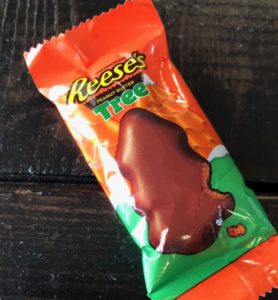
Merry Christmas indeed.
Round #3: Best for Sharing
Want to make someone’s day brighter? Reese’s, the answer is Reese’s. In the spirit of easy sharing, there’s one shape with a design that naturally lends itself to sharing.
The winter: the Reese’s Heart. You could easily split it in half to share your Reese’s with someone.
But, who wants to do that? Reese’s shapes aren’t meant to be shared. If you really want to share with someone, you get them their own bag. End of story. This category is bogus, I’m done with it, and the Reese’s Heart has been eliminated from the competition.
Round #4: The Holiday’s Choice Candy
Every season has its recurring candy staples, the stuff you always know is coming. Think Cadbury eggs for Easter, candy hearts with sweet phrases at Valentine’s, and fun-size everything for Halloween.
One of the seasons in which we find a Reese’s shape is severely lacking in its own special identity: Christmas. Don’t get me wrong, there are always plenty of Christmas-themed candies, but there isn’t one true standout, one unique staple of the holiday. I think that’s because there are so many foods associated with Christmas. Candy is often the last thing on anyone’s mind when there are Christmas cookies, fudge, pies, and a smorgasbord of sweet treats all throughout the season.
The winner: the Reese’s Christmas Tree. Every other season has pretty stiff competition when it comes to themed candy (looking at you, Cadbury chocolate eggs) so the tree easily stands out as the best option to take the trophy as the hallmark Christmas-themed candy.
Round #5: The Nostalgia Factor
There’s something to be said for throwbacks. Things that bring up pleasant memories. Your first time experiencing something.
That said, the winner of this category is the one that started it all, the one that set the stage for many years of happy, holiday-themed snacking.
The winner: the Reese’s Egg.

The best of all the Reese’s – the Egg.
Coming in second to the Egg, again: the Reese’s Pumpkin.
I think back to my own college years when my roommate Heidi and I had a philosophy during the Easter season of, “An egg a day.” Simply meaning, we felt it was appropriate and necessary to eat a Reese’s egg every day. And we did. We kept them in the fridge, oh they were just chilled perfection and something I think we both looked forward to after a long day of class and work. Ah, memories.
The Best Reese’s Holiday Shape
The competition has been pretty stiff, with all five choices showing up in at least one category.
It wasn’t an easy decision. After careful deliberation and all things considered, I declare the winner of the Reese’s holiday shapes to be: The Reese’s Egg.
While the Christmas Tree took two categories and the Pumpkin was close to the Egg in both of its categories, for me the final decision was both the Egg’s nostalgia factor and it’s ideal peanut-butter-to-chocolate ratio.
But here’s the really good news: All five shapes are delicious. Enjoy them all with each new season. Just be sure to stock up on Eggs during the Easter season because it can get long waiting for Fall and the Pumpkin and Bat to make their appearances.
Your turn: Which Reese’s holiday shape is your favorite? The comments are all yours so please share.
Connect with me @lindsayinreallife on Instagram or @lindsayIRL on Twitter. Subscribe to Wellness in Real Life so you get every new blog post right to your inbox.
Best Foods to Eat for Runners and Training for a Marathon
“Food is fuel.”
Training for any race, whether a 5k, half marathon, 10 mile or 10k, requires dedication, good sleep, logging miles, and food – lots of food. The question is: what are the best foods to eat for runners?
Fueling is important in everyday life and especially important for runners. One of my biggest challenges is finding new, good ideas for marathon fueling. Especially right now, as I’m in my middle phase, soon approaching my peak weeks, the appetite increases and so, too does the need for good fuel ideas.

One rule of training – food is fuel.
Additionally, I’ve had to experiment with my food choices throughout the years. Certain foods fuel my runs better than others, while some foods don’t sit well in my stomach on long run days. I think every runner goes through this to a degree and it’s all about finding what foods work best for you. Another great reason to track food (but without counting calories).
In the spirit of always being on the search for the best marathon training foods, I thought I’d share a few of my favorite marathon training foods and, in my case, all of these are vegetarian so a little bump for those looking to eat more veg-friendly foods and still feel well-fueled.
Breakfast
My go-to breakfast before a run is a whole wheat waffle with peanut butter and half a banana sliced on top. If I need a little extra energy, I’ll top the other half of the banana in peanut butter and enjoy that, too.
On non-race days, another breakfast I love is oatmeal with a spoonful of a plant protein powder like pumpkin seed or hemp.
Lunch
On run days, lunch is usually lighter for me. I’m one of those people who’s not hungry after running – my runger usually sets in the day after a long run.
One of my favorites, especially because I usually train for marathons in the winter, is two slices of avocado toast topped with fried eggs and a little cheese, along with a side of veggie or bean-rich soup. If you want to add an extra punch of good to avocado toast, include mixed greens, cucumbers, or tomatoes.
Other days, I love a good salad with a hardboiled egg and cottage cheese, along with a side of tater tots. Yep, that’s right, tater tots. They’ve proven time and time again to be great fuel for an evening run plus they’re tasty and a great starchy compliment to a protein and veggie-heavy salad.

Waffles – pretty much great fuel anytime.
Finally, a Jimmy John’s veggie sub is probably my favorite lunch – often, I eat JJs the day before a long run, sometimes, I’ll eat it after a long run. Other days, I’ll just eat it because it’s tasty and always makes my stomach happy.
Dinner
Carbs are good, they’re not evil. And especially a dinner the night before a run or after one, carbs are good fuel and replenishment.
It’s so runner cliché to eat pasta but it’s true for a reason. What I like to do is mix up traditional pasta like noodles or spinach tortellini with zucchini noodles (I’ve also tried carrot, squash, and other veggie noodle varieties), plus add a ton of veggies like artichokes, spinach, and olives, then top with a light, garlicky tomato sauce.
On lazy days, I’ll take a frozen meal (Amy’s bowls are my favorite) like mac and cheese with broccoli or pesto tortellini, then add a bunch of my own veggies to it.
Other days, tacos are one of my favorite dinners and, best of all, you can mix up the ingredients based on what you’re feeling or what you need to clean out of the fridge (the latter if often me).
Some combos I enjoy are typical, others have a unique twist – here are three:
A black bean burger crumbled up with some tomatoes, spinach and ranch dressing.
Eggs, Spanish rice, tomatoes, spinach, and salsa.
Quinoa, black beans, zucchini, squash, spinach, and salsa.

Throw anything & everything in tacos.
Finally, breakfast food is my favorite food – so breakfast for dinner is a frequent occurrence. A couple eggs on toast with a sweet potato or scrambled eggs with a waffle topped with berries. Even if it’s just straight up pancakes for dinner. The possibilities of breakfast know no limits.
Snacks
Oh, snacks. I love snacks. Whether a small snack or one much larger, I’m not a three-meals-a-day kind of gal. I need the snacks.
Speaking of breakfast foods being the best, a bowl of cereal with skim milk is often the best snack, any time of day. I tend to go with either a mix of fiber and sweet like Frosted Mini Wheats or Raisin Bran, or simple like Rice Chex or Special K.
When it comes to smaller snacks, Belvita protein bars have become one of my favorites.
Berries, grapes, mangos, oranges, really any fruit is also high on the list.
Hardboiled eggs are another good snack if I don’t have eggs planned for one of my other meals; I usually eat three, one with the yolk, the others just the whites.
And, of course, Reese’s. Can’t go wrong with Reese’s, all day, every day.
Fellow runners, please share your favorite training staple, whether a meal or a snack. I’m always looking for new ideas.
The comments are yours so please share.
Connect with me @lindsayinreallife on Instagram or @LindsayIRL on Twitter. Subscribe to Wellness in Real Life so you get every new blog post straight to your inbox.
